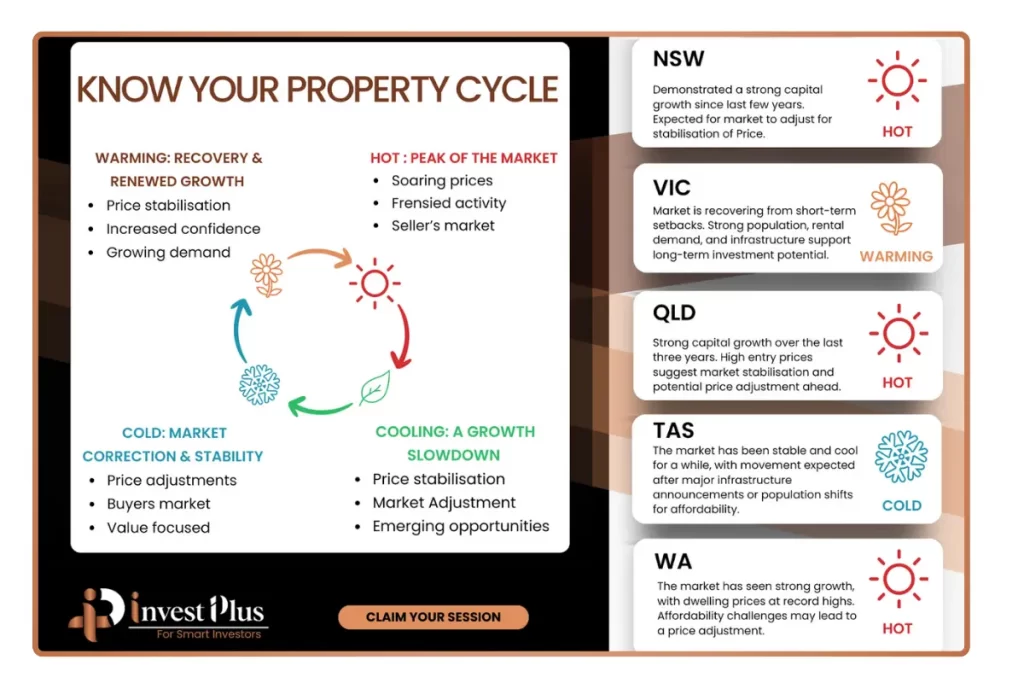Investing in property is a powerful way to build long-term wealth. However, as a first-time investor, it’s essential to understand the core principles before diving in. This guide outlines six critical things every new investor should know to make informed, successful property investment decisions.
Table of Contents
- Know Your Property Cycle
- Choosing the Right Property at the Right Price
- The Importance of Cash Flow
- The Role of a Good Property Strategist
- Market Dynamics and Local Insights
- Planning for Long-Term Success
1.Know Your Property Cycle
Understanding the property cycle is one of the most crucial steps for any investor. Much like the changing seasons, the real estate market operates in cycles: Recovery (Spring), Upswing (Summer), Downturn (Autumn), and Stagnation (Winter). Each phase brings unique dynamics, and knowing where the market stands can help you make smarter investment decision

The Four Seasonal Phases of the Property Cycle:
- Spring (Recovery): The market starts to stabilise, with increasing buyer interest and early signs of price growth.
- Summer (Upswing): Demand surges rapidly, leading to rising prices and competitive market conditions.
- Autumn (Downturn): Supply begins to exceed demand, prices soften, and buyer enthusiasm wanes.
- Winter (Stagnation): The market quietens, with stable property values and fewer transactions.
Where Are Australian Cities in 2025?
Here’s a breakdown of the property cycle phases for major Australian cities:
State | City | Seasonal Phase | Market Dynamics |
| Queensland | Gold Coast | Summer (Upswing) | Strong demand, rapid price increases. |
| Queensland | Brisbane | Spring (Recovery) | Market recovering with early growth signs. |
| South Australia | Adelaide | Summer (Upswing) | Surging demand and price growth. |
| New South Wales | Sydney | Summer (Upswing) | Competitive bidding and rapid price increases. |
| Victoria | Melbourne | Spring (Recovery) | Gradual recovery with emerging opportunities. |
| Western Australia | Perth | Winter (Stagnation) | Stable market conditions, limited activity. |
| Tasmania | Hobart | Winter (Stagnation) | The market stabilised with balanced supply/demand. |
By understanding where different cities are in their cycles, you can time your investment to take advantage of emerging opportunities or avoid overpaying during a peak.
2. Choosing the Right Property at the Right Price
Choosing the right property at the right price is one of the most critical steps in property investment. Your choice will significantly impact your returns and long-term wealth. Here are key factors to consider when making your decision:
- Local Market Research: Research local property trends, pricing, and areas with potential for growth. Pay attention to infrastructure developments, like new public transport links or commercial projects, as these can increase property values over time.
- Capital Growth Potential: Look for areas that show promise for capital growth in the future. Population growth, urban renewal, and the expansion of local amenities can increase the desirability of a property, leading to higher returns in the long term.
- Rental Demand: Ensure the area you invest in has strong rental demand. If there’s a high demand for rental properties, you’ll have a steady stream of income and avoid prolonged vacancy periods.
- Price vs. Value: Don’t be swayed by properties that are priced higher than their true market value. Compare similar properties in the area to ensure you’re getting a fair price. Sometimes, high commissions and inflated marketing costs can artificially increase property prices.
- Independent Valuations: Always seek an independent valuation to avoid paying more than the property is worth. This is especially important when buying in unfamiliar markets, such as interstate or overseas locations.
3. The Importance of Cash Flow
One of the key principles in property investment is managing cash flow. Positive cash flow means that your rental income is enough to cover ongoing expenses, such as mortgage repayments, maintenance, and management fees. Positive cash flow helps ensure you can hold onto the property even in times of vacancy or unforeseen costs.
Example:
Imagine purchasing a property that rents for $2,500 per month. Your mortgage repayments are $1,800, maintenance costs are $200, and management fees are $200. After these expenses, you’re left with $300 in monthly cash flow. This positive cash flow provides a cushion for any unexpected costs, such as emergency repairs or a few months of vacancy, without dipping into your savings.
Make sure to account for all potential expenses, and confirm that the property’s income is sustainable over time. This will help you avoid financial strain down the road.
4. The Role of a Good Property Strategist
A skilled property strategist can be a game-changer for first-time investors. Their role goes beyond helping you find a property—they provide tailored advice aligned with your financial goals and current market conditions.
How a Property Strategist Adds Value:
- Identifying High-Growth Areas: Strategists track property trends and infrastructure developments to help you target locations with strong future potential.
- Portfolio Diversification: For investors building long-term wealth, strategists can recommend properties across different states or regions to mitigate risks.
- Market Insights: Their expertise ensures you’re aware of market phases, giving you a competitive edge when buying or selling.
- Negotiation Support: Strategists can negotiate on your behalf to secure the best deals, including off-market opportunities.
Unlike a traditional real estate agent who may focus on selling specific properties, a strategist prioritises your financial success, ensuring your property aligns with your broader wealth-building plan.
5. Market Dynamics and Local Insights
Understanding local market dynamics is crucial for making informed investment decisions. Property markets are influenced by a variety of factors, including:
- Infrastructure Developments: The construction of new roads, public transport links, or major facilities like hospitals or schools can greatly impact property values. Research the infrastructure projects planned for the area to gauge its future growth potential.
- Demographic Trends: Changes in the local population, such as increasing numbers of young professionals or retirees, can affect the types of properties in demand. For example, if a neighborhood is attracting more young families, there may be a higher demand for larger homes with easy access to schools and parks.
- Population Growth: Areas with a growing population typically see a rise in housing demand, which can drive up property prices and rental income.
- Economic Conditions: A strong local economy supports the property market by increasing demand for housing. Job growth, business investment, and economic development can all help drive property values higher.
- Planned Developments: Future projects, such as commercial sones, recreational spaces, or new residential developments, can further elevate the long-term value of properties in the area. Stay updated on signing and planning changes, as these can signal areas of future growth.
By understanding the market dynamics and speaking with local real estate professionals, you can get a clearer picture of a property’s long-term potential.
6. Planning for Long-Term Success
Property investment is a long-term strategy. While the initial steps may seem daunting, success in property investing typically requires patience, careful management, and planning. Rather than focusing on short-term market fluctuations, keep your eye on your long-term goals.
To ensure long-term success, maintain your property to keep it attractive to tenants. Monitor capital growth opportunities and regularly assess market trends. Regularly reviewing your financial situation and property performance will help you adapt your strategy as needed to stay on track for long-term wealth accumulation.
Conclusion
Purchasing an investment property is a significant financial decision. By understanding the fundamentals—such as selecting the right property, managing cash flow, and leveraging market insights—you can approach property investment with confidence. With the right research, a solid strategy, and long-term planning, you’ll be well-equipped to navigate the complexities of property investment and build lasting wealth.
By focusing on these six critical areas, you’ll be able to make informed decisions that will set you up for financial success in the property market.
At InvestPlus, we provide diverse products including house and land packages throughout Australia, strategically positioned in locations recognised for their Strong growth prospects. By collaborating with trusted developers and builders, we ensure the quality and value of your investment. For further information on securing your real estate investment through strategic planning, please contact us using the details provided below.

